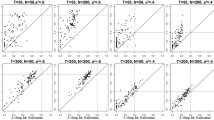Abstract
A battery of psychomotor tasks and physiological measures was administered to 206 pairs of twins before alcohol and then three times at hourly intervals after they ingested a standard dose of ethanol (0.75 g/kg body weight). Repeat measurements were obtained for 41 of these pairs on a second occasion. Performance on motor coordination, standing steadiness, pursuit rotor, arithmetic computation, and reaction-time tasks deteriorated after alcohol, but decrements on the five tasks were generally independent of each other. Measurements of blood pressure, pulse rate, and skin temperature were all elevated following alcohol intake, but these responses were also uncorrelated. The variance in many of these measures increased after alcohol. An analysis of covariance structure revealed that most of this additional variance exposed by alcohol was genetic in origin, particularly for standing steadiness, pursuit rotor, arithmetic computation, and pulse rate. Up to 50% of the variance in body sway after alcohol was estimated to be due to genetic factors expressed only under the influence of alcohol. Although significant correlations were found with blood alcohol concentration, previous drinking experience, and the personality trait Extraversion, little of the genetic variance exposed by alcohol could be explained by these predictors. It is concluded that the sources of the considerable genetic variation affecting performance under alcohol must be sought elsewhere.
Similar content being viewed by others
References
Belgrave, B. E., Bird, K. D., Chesher, G. B., Jackson, D. M., Lubbe, K. E., Starmer, G. A., and Teo, R. I. C. (1976). The effect of tetrahydrocannabinol alone and in combination with ethanol, on human performance.Psychopharmacology 62:53–60.
Eaves, L. J., Last, K. A., Young, P. A., and Martin, N. G. (1978). Model-fitting approaches to the analysis of human behaviour.Heredity 41:249–320.
Eysenck, H. J., and Eysenck, S. B. G. (1975).Manual of the Eysenck Personality Questionnaire, Hodder & Stoughton, London.
Eysenck, S. B. G., and Eysenck, H. J. (1977). The place of impulsiveness in a dimensional system of personality description.Br. J. Soc. Clin. Psychol. 16:57–68.
Franks, H. M., Hensley, V. R., Hensley, W. J., Starmer, G. A., and Teo, R. K. C. (1976). The relationship between alcohol dosage and performance decrement in humans.J. Stud. Alc. 37:284–297.
Goldberg, L. (1966). Behavioral and physiological effects of alcohol on man.Psychosom. Med. 28:570–595.
Idestrom, C.-M., and Cadenius, B. (1968). Time relations of the effects of alcohol compared to placebo.Psychopharmacologia 13:189–200.
Jardine, R., and Martin, N. G. (1984). Causes of variation in drinking habits in a large twin sample.Acta Genet. Med. Gemellol. 33:435–450.
Martin, N. G., and Eaves, L. J. (1977). The genetical analysis of covariance structure.Heredity 38:79–95.
Martin, N. G., Eaves, L. J., Kearsey, M. J., and Davies, P. (1978). The power of the classical twin study.Heredity 40:97–116.
Martin, N. G., Eaves, L. J., and Fulker, D. W. (1979). The genetical relationship of impulsiveness and sensation seeking to Eysenck's personality dimensions.Acta Genet. Med. Gemellol.,28:197–210.
Martin, N. G., Gibson, J. B., Oakeshott, J. G., Wilks, A. V., Starmer, G. A., Craig, J., and Perl, J. (1981). A twin study of psychomotor performance during alcohol intoxication: Early results. InTwin Research 3: Epidemiological and Clinical Studies, Alan R Liss, New York, pp. 89–96.
Martin, N. G., Perl, J., Oakeshott, J. G., Gibson, J. B., Starmer, G. A., and Wilks, A. V. (1983). A twin study of ethanol metabolism.Behav. Genet. 15:93–109.
Powell, B. J., Goodwin, D. W., and Bremer, D. (1973). Drinking experience versus personality factors as predictors of tolerance for alcohol.Br. J. Psychiat. 122:415–417.
Propping, P. (1977a). Genetic control of ethanol action on the central nervous system: An EEG study in twins.Hum. Genet.,35:309–334.
Propping, P. (1977b). Psychophysiologic test performance in normal twins and in a pair of identical twins with essential tremor that is suppressed by alcohol.Hum. Genet. 36:321–325.
Wait, J. S., Welch, R. B., Thurgate, J. K., and Hineman, J. (1982). Drinking history and sex of subject in the effects of alcohol on perception and perceptual motor coordination.Int. J. Addict. 17:445–462.
Williams, L. R. T., and Gross, J. B. (1980). Heritability of motor skill.Acta Genet. Med. Gemellol. 29:127–136.
Vogel-Sprott, M. D. (1979). Acute recovery and tolerance to low doses of alcohol: Differences in cognitive and motor skill performance.Psychopharmacology 61:287–291.
Author information
Authors and Affiliations
Additional information
This work was supported by the Australian Associated Brewers.
Rights and permissions
About this article
Cite this article
Martin, N.G., Oakeshott, J.G., Gibson, J.B. et al. A twin study of psychomotor and physiological responses to an acute dose of alcohol. Behav Genet 15, 305–347 (1985). https://doi.org/10.1007/BF01070893
Received:
Accepted:
Issue Date:
DOI: https://doi.org/10.1007/BF01070893




